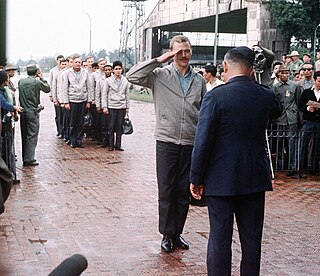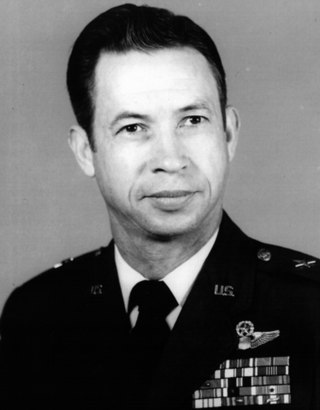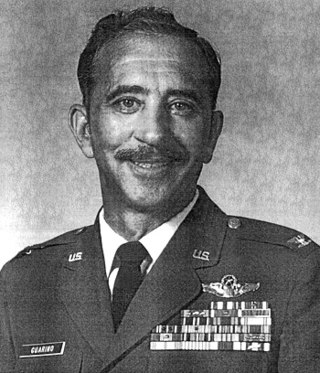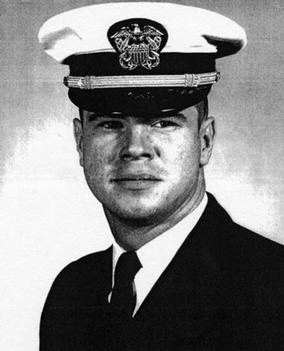Background
The first group of American POWs leaving North Vietnamese prison camps left Hanoi on a United States Air Force (USAF) Lockheed C-141 Starlifter nicknamed the Hanoi Taxi, which flew them to Clark Air Base in the Philippines for medical examinations. On March 17, the plane landed at Travis Air Force Base in Solano County, California. Even though there were only twenty POWs of that first increment released aboard the plane, almost 400 family members turned up for the homecoming. [3]
USAF Lieutenant Colonel Robert L. Stirm made a speech [4] "on behalf of himself and other POWs who had arrived from Vietnam as part of Operation Homecoming." [5]
Smithsonian Magazine says that "Veder, who'd been standing in a crowded bullpen with dozens of other journalists, noticed the sprinting family and started taking pictures. 'You could feel the energy and the raw emotion in the air'." [5] [4]
Veder then rushed to the makeshift photo developing station (for 35 mm film) in the ladies' room of the air base's flightline washrooms, while the photographers from United Press International were in the men's. [4] Smithsonian Magazine says that "In less than half an hour, Veder and his AP colleague Walt Zeboski had developed six remarkable images of that singular moment. Veder's pick, which he instantly titled Burst of Joy, was sent out over the news-service wires". [5]
Subjects
The photograph depicts United States Air Force Lieutenant Colonel Robert L. Stirm being reunited with his family, after spending more than five years in captivity as a prisoner of war in North Vietnam. On October 27, 1967, Stirm was shot down over Hanoi while leading a flight of F-105s on a bombing mission, and was not released until March 14, 1973. The centerpiece of the photograph is Stirm's 15-year-old daughter Lorrie, who is excitedly greeting her father with outstretched arms, as the rest of the family approaches directly behind her. [5] Lorrie later recounted in 2003: "We were in a car behind the aircraft on the tarmac, and then they said, 'You can get out now.' So we just burst out of the car and started running to my dad. . . We were very excited." [6] Lorrie's exuberant reaction earned her moniker "The Jumper" or "The Leaper". [7]
Despite outward appearances, the reunion was an unhappy one for Stirm. Three days before he arrived in the United States, the same day he was released from captivity, Stirm received a Dear John letter from his wife Loretta informing him that their marriage was over. Stirm later learned that Loretta had been with other men throughout his captivity and had received marriage proposals from three of them. In 1974, the Stirms divorced and Loretta remarried, but he was still ordered to provide her with 43% of his military retirement pay once he retired from the Air Force, [8] although the divorce judge stated that much evidence was presented to the court of Loretta's infidelity while Stirm was a prisoner. Stirm was later promoted to colonel and retired from the Air Force in 1977. [9] Loretta died on August 13, 2010, from cancer. [10]
After Burst of Joy was announced as the winner of the Pulitzer Prize, all of the family members depicted in the picture received copies. The depicted children display it prominently in their homes, but not Colonel Stirm, who in 2005 said he could not bring himself to display the picture. [5]
Lorrie Stirm appeared on Antiques Roadshow on January 2, 2023, seeking an appraisal for an archive of items relating to the event: Lorrie's personal print of the famous photograph (signed by the photographer in 1990), Lt. Col. Stirm's prison uniform, Red Cross luggage with a North Vietnamese tag, a spoon engraved with "Lt. Col. Stirm" and a thunderbolt that was made during his imprisonment, and a pair of sandals that the North Vietnamese claimed were made from the wheels of Stirm's crashed plane. Auctioneer Joel Bohy valued the items as worth $2500–3000 at auction, but said the "historical value on this is absolutely priceless". [7]
Reactions
About the picture and its legacy, Lorrie Stirm Kitching once noted, "We have this very nice picture of a very happy moment, but every time I look at it, I remember the families that weren't reunited, and the ones that aren't being reunited today—many, many families—and I think, I'm one of the lucky ones." [5]
Donald Goldstein, a retired Air Force colonel and a co-author of a prominent Vietnam War photojournalism book, The Vietnam War: The Stories and The Photographs, says of Burst of Joy, "After years of fighting a war we couldn't win, a war that tore us apart, it was finally over, and the country could start healing." [5]

Hỏa Lò Prison was a prison in Hanoi originally used by the French colonists in Indochina for political prisoners, and later by North Vietnam for U.S. prisoners of war during the Vietnam War. During this later period, it was known to American POWs as the "Hanoi Hilton". Following Operation Homecoming, the prison was used to incarcerate Vietnamese dissidents and other political prisoners, including the poet Nguyễn Chí Thiện. The prison was demolished during the 1990s, although its gatehouse remains a museum.

George Thomas Coker is a retired United States Navy commander who was awarded the Navy Cross for extraordinary heroism as a prisoner of war (POW) during the Vietnam War. An Eagle Scout, he is noted for his devotion to Scouting.

Everett Alvarez Jr. is a retired United States Navy officer who endured one of the longest periods as a prisoner of war (POW) in U.S. military history. Alvarez was the first U.S. pilot to be shot down and detained during the Vietnam War and spent over eight years in captivity, making him the second longest-held U.S. POW, after U.S. Army Colonel Floyd James Thompson.

Hanoi Taxi is a Lockheed C-141 Starlifter strategic airlift aircraft that was in service with the United States Air Force and became famous for bringing back the first returned prisoners of war in Operation Homecoming. This aircraft, which was delivered to the Air Force in 1967, was the last C-141 to be withdrawn from service after a career of 43 years.
The following are the Pulitzer Prizes for 1974.

Operation Homecoming was the return of 591 American prisoners of war (POWs) held by North Vietnam following the Paris Peace Accords that ended U.S. involvement in the Vietnam War.

Colonel James Helms Kasler was a senior officer in the United States Air Force and the only person to be awarded the Air Force Cross three times. The Air Force Cross ranks just below the Medal of Honor as an award for extraordinary heroism in combat.

John Arthur Dramesi was a United States Air Force (USAF) colonel who was held as a prisoner of war from 2 April 1967 to 4 March 1973 in both Hoa Lo Prison, known as "The Hanoi Hilton", and Cu Loc Prison, "The Zoo", during the Vietnam War.

The Vietnam War POW/MIA issue concerns the fate of United States servicemen who were reported as missing in action (MIA) during the Vietnam War and associated theaters of operation in Southeast Asia.

Norman Carl Gaddis was a United States Air Force officer, fighter pilot and prisoner of war. At the time he was shot down over North Vietnam, Gaddis was the most senior United States Air Force officer (Colonel).
Colonel Leroy W. Stutz was a U.S. Air Force officer, pilot and prisoner of war for 2,284 days during the Vietnam War.

Lawrence Nicholas "Larry" Guarino was a United States Air Force officer, and veteran of three wars. Shot down on his 50th combat mission, he spent more than eight years as a prisoner of war (POW) during the Vietnam War and earned the Air Force Cross.
The Hanoi March was a propaganda event held on July 6, 1966, involving U.S. prisoners of war during the Vietnam War. During the march, members of the North Vietnamese Army paraded 52 American POWs through the streets of Hanoi before tens of thousands of North Vietnamese civilians. The march soon deteriorated into near riot conditions, with North Vietnamese civilians beating the POWs along the 2 miles (3.2 km) route and their guards largely unable to control the melee.
Members of the United States armed forces were held as prisoners of war (POWs) in significant numbers during the Vietnam War from 1964 to 1973. Unlike U.S. service members captured in World War II and the Korean War, who were mostly enlisted troops, the overwhelming majority of Vietnam-era POWs were officers, most of them Navy, Air Force, and Marine Corps airmen; a relatively small number of Army enlisted personnel were also captured, as well as one enlisted Navy seaman, Petty Officer Doug Hegdahl, who fell overboard from a naval vessel. Most U.S. prisoners were captured and held in North Vietnam by the People's Army of Vietnam (PAVN); a much smaller number were captured in the south and held by the Việt Cộng (VC). A handful of U.S. civilians were also held captive during the war.
Richard Paul Keirn was a colonel and fighter pilot in the United States Air Force. He was one of two United States service members to be a prisoner of war (POW) in both World War II and the Vietnam War and was the first US airman to be shot down by a surface-to-air missile (SAM) during the Vietnam War.

Hayden James Lockhart is a retired United States Air Force officer who is best known for being the first U.S. Air Force pilot to be shot down in North Vietnam.

Brigadier General Ralph Thomas "Tom" Browning was a United States Air Force command pilot and a prisoner of war (POW) during the Vietnam War. He commanded two air divisions during his career, and was commander of the 58th Fighter Wing, Luke Air Force Base, Arizona. After retirement from the USAF, he became CEO of Greater Phoenix Leadership, Inc. in Phoenix, Arizona, a business organization supporting community improvement efforts in the areas of transportation, education and economic development.

Lieutenant Commander James J. Connell was an American naval aviator. Born in Wilmington, Delaware, Connell served in the United States Navy as a naval aviator. During the Vietnam War, Connell was shot down and captured, eventually dying in captivity. He was posthumously awarded the Navy Cross, with Connell's decoration being the highest award for valor bestowed on a Delawarean during the Vietnam War.

Lieutenant General John Peter Flynn was a lieutenant general in the United States Air Force (USAF) who served in World War II, the Korean War and the Vietnam War. He was the senior American prisoner of war in North Vietnam from October 1967 to March 1973. Following his release from captivity he continued his USAF career, finally serving as the 21st Inspector General of the Air Force.
Ronald E. Storz was a United States Air Force pilot and recipient of the Air Force Cross who died in captivity as a prisoner of war during the Vietnam War.














